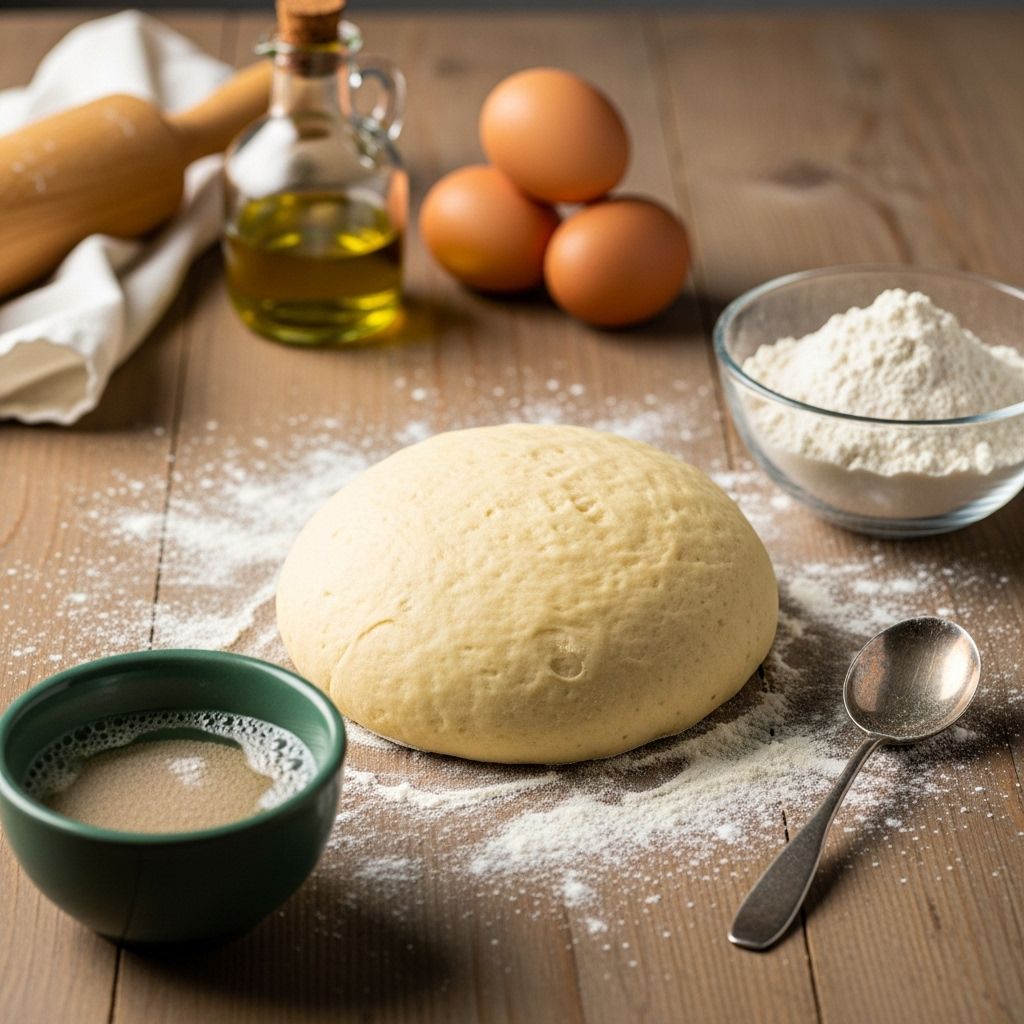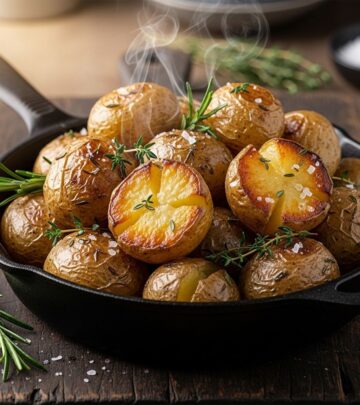Homemade Pizza Dough Recipe: Complete Step-By-Step Guide
Master the art of homemade pizza dough with this detailed, foolproof recipe—from mixing to baking, for pillowy crusts every time.

Image: HearthJunction Design Team
Perfect Homemade Pizza Dough: Your Ultimate Step-by-Step Guide
There’s nothing quite like the aroma and taste of fresh, homemade pizza, and it all starts with the right dough. Whether you’re a beginner or an experienced baker, this in-depth guide will walk you through the process of making classic pizza dough from scratch, ensuring you get a crust that’s fluffy, chewy, and crisp every time.
Table of Contents
- Introduction to Homemade Pizza Dough
- Essential Ingredients
- Equipment You’ll Need
- Step-By-Step Instructions
- Expert Tips & Tricks
- Flavor Variations & Customization Ideas
- How to Store and Freeze Pizza Dough
- Frequently Asked Questions (FAQs)
Introduction to Homemade Pizza Dough
Making pizza dough by hand is a rewarding experience that gives you complete control over your pizza crust’s flavor and texture. Homemade dough is typically more flavorful, fresher, and customizable than anything store-bought. Best of all, you only need a handful of pantry ingredients and a little patience while the dough rises. This guide simplifies the process, letting you focus on techniques that work every time.
Essential Ingredients
This classic pizza dough recipe uses simple, everyday ingredients found in most kitchens. Here’s what you’ll need:
- All-purpose flour (or bread flour)
- Warm water (about 110°F/43°C)
- Instant or active dry yeast
- Sugar (fuels the yeast and helps browning)
- Salt (for flavor)
- Olive oil (adds richness and chew)
- Cornmeal (for dusting the pan, optional)
| Ingredient | Purpose |
|---|---|
| Flour | Structure and chew of crust |
| Warm Water | Activates yeast, forms gluten |
| Yeast | Leavens dough, airy texture |
| Sugar | Feeds yeast, browns crust |
| Salt | Enhances flavor |
| Olive Oil | Makes crust tender, flavorful |
| Cornmeal | Prevents sticking, adds crunch (optional) |
Equipment You’ll Need
- Large mixing bowl (or stand mixer with dough hook)
- Measuring cups and spoons
- Whisk or spoon for mixing
- Plastic wrap or clean towel (for covering dough)
- Baking sheet, pizza stone, or pizza steel
- Rolling pin (optional—stretching by hand is traditional)
- Pastry brush (for oiling dough, optional)
Step-By-Step Instructions
- Activate the Yeast
In a large mixing bowl, combine warm water, sugar, and yeast. Whisk gently and let sit for 5 minutes until foamy. This ensures the yeast is active and ready to help the dough rise.
- Mix the Dough
Add the flour, olive oil, and salt to the bowl. Use a spoon, spatula, or the paddle/dough hook attachment on a stand mixer to combine on medium speed. Mix until a shaggy dough forms and pulls away from the sides.
- Knead the Dough
Transfer dough to a floured surface. Knead by hand for 7–10 minutes (or use a stand mixer on medium for about 5 minutes) until the dough is smooth, elastic, and only slightly tacky.
Make your dreams of pizzeria-style pizza come true with our Foolproof Pan Pizza: Easy Guide to Pizzeria-Style Perfection. This guide will help you achieve a thick, golden crust that's crispy on the outside and delightfully fluffy on the inside. - First Rise (Bulk Fermentation)
Place the dough in a lightly oiled bowl. Turn it to coat all sides. Cover the bowl with plastic wrap or a clean towel and let rise in a warm, draft-free area for 60–90 minutes, until doubled in size.
- Punch Down and Divide
Once risen, punch down the dough gently to release gases. Turn onto a floured surface, divide into two equal portions (each will make a 12-inch pizza), and shape into balls.
- Rest the Dough
Let dough balls rest, covered, for 15–20 minutes. This relaxes the gluten and makes stretching easier.
- Preheat Oven & Prepare Pan
Place a pizza stone or steel in the oven (if using) and preheat to the highest temperature your oven allows (475–500°F or 245–260°C) for at least 30–60 minutes. Sprinkle cornmeal on your pizza peel or pan.
- Shape the Crust
On a floured surface, press and stretch one dough ball into a 12-inch circle, using your fingers or a rolling pin. Avoid overworking, which can toughen the crust. Place on prepared peel or pan.
- Add Toppings & Bake
Brush the edge of the crust with olive oil and add desired sauce, cheese, and toppings. Bake pizza for 12–15 minutes or until the crust is golden and the cheese is bubbling. Let cool slightly before slicing and serving.
Expert Tips & Tricks
- Use Bread Flour for Chewier Crust: Bread flour (higher protein) makes the crust chewier; all-purpose flour yields a softer bite.
- Check Water Temperature: Water that is too hot can kill yeast; water that is too cold will slow rising. Aim for 105–115°F (40–45°C).
- Don’t Skip the Rest: Allowing dough to rest after kneading and before stretching makes it more pliable and easier to shape.
- For Crispier Crusts: Prebake the shaped dough for 5 minutes before topping and finishing the bake.
- Dust with Cornmeal: Sprinkling cornmeal on your pan or peel prevents sticking and adds subtle crunch.
- Batch and Freeze: Make extra dough and freeze portions for up to 3 months. Thaw in the fridge and bring to room temperature before shaping.
Suggested Toppings
- Classic: Tomato sauce, mozzarella, pepperoni, basil
- Veggie: Roasted bell peppers, onions, olives, mushrooms
- White pizza: Olive oil, garlic, ricotta, spinach, mozzarella
- BBQ chicken: Barbecue sauce, cooked chicken, red onion, cilantro
Flavor Variations & Customization Ideas
Personalize your pizza dough and crust with these creative ideas:
- Herbed Crust: Knead in dried basil, oregano, rosemary, or garlic powder for extra aroma and flavor.
- Whole Wheat Dough: Substitute up to half the flour with whole wheat for a nutty, wholesome crust.
- Cheese-Stuffed Crust: Roll small pieces of mozzarella into the dough edges for gooey, cheesy bites.
- Gluten-Free: Use a gluten-free flour blend and check yeast instructions; gluten-free dough may require a different approach.
- Butter Parmesan Finish: After baking, brush crust with melted butter and sprinkle with grated parmesan and herbs.
How to Store and Freeze Pizza Dough
Pizza dough is ideal for making in advance.
- Refrigerate: Place dough balls in oiled zip-top bags or airtight containers and refrigerate for up to 3 days. Let come to room temperature before shaping.
- Freeze: Wrap dough balls in plastic wrap and place in freezer bags. Freeze up to 3 months. Thaw overnight in the refrigerator, then bring to room temperature before using.
To use refrigerated or frozen dough, let it rest at room temperature for 30–60 minutes to relax the gluten before stretching and topping your pizza.
Frequently Asked Questions (FAQs)
Q: How do I know if my yeast is active?
A: After mixing the yeast with warm water and sugar, it should become foamy and bubbly (within 5–10 minutes). If there’s no activity, the yeast may be too old or the water temperature was off.
Q: What’s the best flour for pizza dough?
A: Bread flour gives chewy, classic pizza texture; all-purpose flour creates a softer bite. Both work well, but results will vary slightly.
Q: Can I make the dough ahead of time?
A: Yes, refrigerate dough for up to 3 days or freeze for up to 3 months. Always let it come to room temperature before shaping.
Q: Why did my dough not rise?
A: Likely causes are old or dead yeast, water that was too hot or cold, or a cool room temperature. Always check yeast freshness and water temperature.
Q: How do I avoid a soggy crust?
A: Preheat your oven and pizza stone/steel thoroughly. Don’t overload pizza with sauce or wet ingredients. A quick prebake of the crust before topping also helps.
Q: Can I use a rolling pin?
A: Yes! A rolling pin will give you a thinner, more uniform crust, while stretching by hand results in a puffier, rustic pizza.
Q: How do I get a blistered and airy crust?
A: Let your dough ferment slowly in the fridge for up to 48 hours for maximum flavor and airiness. Bake on a very hot stone or steel.
Q: Is cornmeal necessary?
A: Cornmeal isn’t required, but it makes it easier to transfer your pizza onto a hot stone and adds a bit of crunch to the bottom.
Final Thoughts
Once you master the basics of homemade pizza dough, a world of creative possibilities opens up. This dough is the perfect canvas for any topping, from classic Margherita to your favorite combinations. Practice makes perfect, so don’t hesitate to experiment with flour types, rest times, and toppings. Enjoy the process!
References
Read full bio of medha deb












